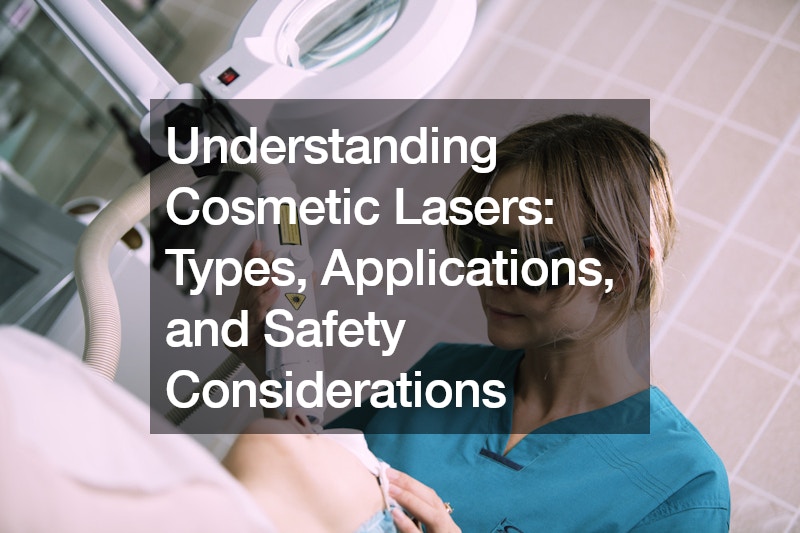Disclaimer: This website provides health information for educational purposes only and is not a substitute for professional medical advice, diagnosis, or treatment. Always seek the guidance of a qualified healthcare provider with any questions you may have.
Cosmetic lasers have revolutionized the field of dermatology, offering a wide range of treatments for various skin concerns. From targeting dark spots and wrinkles to reducing redness and improving skin texture, laser technology has become an integral part of many skincare routines. In this comprehensive guide, we will delve into the different types of cosmetic lasers, their applications, crucial safety considerations, and additional relevant topics for those considering laser treatment for skin.
Types of Cosmetic Lasers
There are several types of cosmetic lasers, each designed to address specific skin concerns. One common type is the fractionated laser, which works deeply within the skin to target wrinkles, scars, and textural changes.
Unlike more aggressive lasers of the past, fractionated lasers create micro-wounds in the skin, promoting collagen production and skin rejuvenation.
Another popular option is intense pulsed light therapy (IPL), which is less intense than fractionated lasers but effective for treating discoloration, redness, and sun damage. IPL therapy utilizes pulses of light to target pigment and blood vessels, resulting in a smoother and more even complexion.
Q-switched lasers are specialized devices used for pigment targeting and tattoo removal. These lasers emit specific wavelengths to break down pigment particles, making them ideal for addressing dark spots and unwanted tattoos.
Radiofrequency devices, while not technically lasers, are often used in conjunction with laser treatments to firm and tighten the skin. These devices deliver heat deep into the skin, stimulating collagen production and improving skin laxity.
Applications of Cosmetic Lasers
Cosmetic lasers offer a wide range of applications, from anti-aging treatments to correcting skin imperfections. Fractionated lasers are particularly effective for reducing wrinkles, scars, and other signs of aging, while IPL therapy is ideal for improving skin tone and reducing redness associated with conditions like rosacea.
Q-switched lasers are commonly used for tattoo removal, targeting pigment with precision and minimal damage to surrounding tissue. Radiofrequency devices are favored for skin tightening and firming, making them popular choices for individuals seeking to improve sagging skin around the neck and jawline.
Safety Considerations
While laser treatments can yield impressive results, it is essential to prioritize safety and choose a qualified provider for your procedure. Dermatologists are highly trained in the science behind lasers and can tailor treatments to your specific skin concerns while minimizing the risk of side effects.
Selecting the right wavelength is crucial in laser therapy to ensure effective targeting of skin concerns and avoid unnecessary damage to surrounding tissue. Improper use of lasers can lead to complications such as hyperpigmentation and scarring, underscoring the importance of seeking treatment from a qualified professional.
Before undergoing laser treatment for skin, it is essential to undergo a thorough evaluation by a dermatologist. This evaluation will help determine the most suitable laser type and treatment plan for your unique skin concerns. Additionally, individuals with a history of post-inflammatory hyperpigmentation or other skin sensitivities should exercise caution when considering certain laser treatments, such as IPL therapy.
Post-Treatment Care
Proper post-treatment care is essential for maximizing the benefits of laser therapy and minimizing the risk of complications. After undergoing laser treatment for skin, it is essential to keep the treated area moisturized and protected from the sun. The skin barrier may be compromised following treatment, making it more susceptible to dryness and sun damage.
Avoiding sun exposure for at least a week following laser treatment is crucial to prevent hyperpigmentation and other adverse reactions. Additionally, patients should adhere to any specific post-procedural instructions provided by their dermatologist to ensure optimal healing and results.
Cost Considerations
One important aspect to consider when contemplating laser treatment for skin is the associated cost. Laser treatments can vary widely in price depending on factors such as the type of laser used, the number of treatments required, and the location of the treatment facility. It is essential to discuss the cost of treatment with your dermatologist and inquire about any financing options or payment plans that may be available.
Expectations and Results
It is essential to have realistic expectations about the results of laser treatment for skin. While lasers can effectively target and improve various skin concerns, multiple treatments may be necessary to achieve the desired outcome fully. Additionally, individual results may vary based on factors such as skin type, age, and overall health. Consulting with a qualified dermatologist can help you understand what to expect from laser treatment and whether it is the right option for you.
Conclusion
Cosmetic lasers offer a versatile and effective solution for addressing a wide range of skin concerns, from aging signs to pigmentation issues. However, safety considerations should always be a top priority when undergoing laser treatment for skin. By choosing a qualified provider, understanding the different types of lasers and their applications, and following proper post-treatment care guidelines, individuals can achieve safe and satisfying results with cosmetic laser treatments. Remember to discuss any questions or concerns with your dermatologist to ensure a positive treatment experience and optimal outcomes.
.
